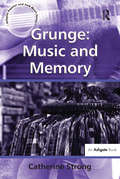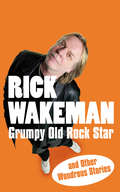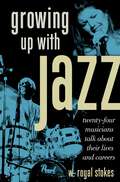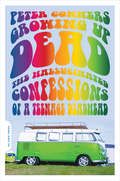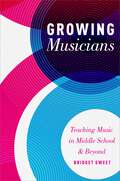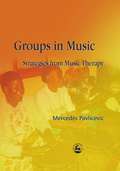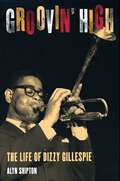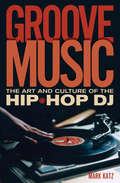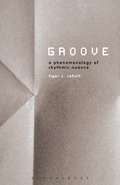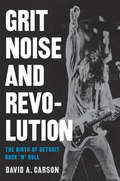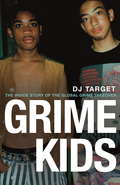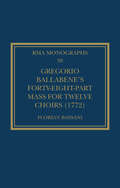- Table View
- List View
Grunge: Music and Memory (Ashgate Popular and Folk Music Series)
by Catherine StrongGrunge has been perceived as the music that defined 'Generation X'. Twenty years after the height of the movement there is still considerable interest in its rise and fall, and its main figures such as Kurt Cobain and Courtney Love. As a form of 'retro' music it is even experiencing a resurgence, and Cobain remains an icon to many young music fans today. But what was grunge, and what has it become? This book explores how grunge has been remembered by the fans that grew up with it, and asks how memory is both formed by and forms popular culture. It looks at the relationship between media, memory and music fans and demonstrates how different groups can use and shape memory as part of an ongoing struggle for power in society. Grunge was the site of such a struggle, as popular music so often is, with the young people of the time asking questions about their place in the world and the way society is organized. This book examines what these questions were, and what has happened to them over time. It shows that although grunge challenged many social structures, the way it, and youth itself, are remembered often work to reinforce the status quo.
Grunge: Music and Memory (Ashgate Popular and Folk Music Series)
by Catherine StrongGrunge has been perceived as the music that defined 'Generation X'. Twenty years after the height of the movement there is still considerable interest in its rise and fall, and its main figures such as Kurt Cobain and Courtney Love. As a form of 'retro' music it is even experiencing a resurgence, and Cobain remains an icon to many young music fans today. But what was grunge, and what has it become? This book explores how grunge has been remembered by the fans that grew up with it, and asks how memory is both formed by and forms popular culture. It looks at the relationship between media, memory and music fans and demonstrates how different groups can use and shape memory as part of an ongoing struggle for power in society. Grunge was the site of such a struggle, as popular music so often is, with the young people of the time asking questions about their place in the world and the way society is organized. This book examines what these questions were, and what has happened to them over time. It shows that although grunge challenged many social structures, the way it, and youth itself, are remembered often work to reinforce the status quo.
Grumpy Old Rock Star: and Other Wondrous Stories
by Rick WakemanAround about August 1948, Mr and Mrs Cyril Wakeman had an early night and some time later, at Perivale in Middlesex, Mrs Wakeman produced a bonny baby son. They named him Richard, but he quickly became known as Rick. Rick was a likeable little fellow who had a talent for the piano and for making trouble. Music became Rick's life - he joined a popular music group called Yes and became a legend. Much later he became a Grumpy Old Man who appears on Countdown, hosts a hugely popular radio show on Planet Rock and performs a one-man show telling stories about his rather extraordinary life.Which is where this book you are holding comes in. Mr Wakeman is simply one of the great storytellers of our age - let's face it, he has some fabulous material. It seemed a shame that some of the funniest yarns should not be more widely known. So he accepted some cash and here we are.Curl up by the fire with a Grumpy Old Rock Star and your nearest and dearest. We defy you not to want to read it aloud and laugh.
Growing up with Jazz: Twenty Four Musicians Talk About Their Lives and Careers
by W. Royal StokesA jazz writer for three decades, W. Royal Stokes has a special talent for capturing the initial spark that launches a musician's career. In Growing Up With Jazz , he has interviewed twenty-four instrumentalists and singers who talk candidly about the early influences that started them on the road to jazz and where that road has taken them. Stokes offers a kaleidoscopic look at the jazz scene, featuring musicians from a dazzling array of backgrounds. Ray Gelato recalls the life of a working class youth in London, Patrizia Scascitelli recounts being a child prodigy in Rome who became the first woman of Italian jazz, and Billy Taylor tells about his childhood in Washington, DC, where his grandfather was a Baptist minister and his father a dentist--and everyone in the family seemed well trained in music. Perhaps most exotic is Luluk Purwanto, an Indonesian violinist who as a child listened to gamelan music in the morning and took violin lessons in the afternoon (on an instrument so expensive she didn't dare quit). For some, the flame burned bright at an early age. Jane Monheit sang before she could speak and was set on a musical career by age eight. Lisa Sokolov played classical piano, sang opera and choral music, and was in a jazz band--all by high school. But Carol Sudhalter, though born into a very musical family ("a Bix Beiderbecke family"), was a botany major at Smith, and only became a serious musician after college, quitting a government job to study the flute and saxophone in Italy. From Art Blakey to Claire Daly to Don Byron, here are the compelling stories of two dozen top musicians finding their way in the world of jazz.
Growing Up Dead: The Hallucinated Confessions of a Teenage Deadhead
by Peter ConnersTold against the backdrop of the American landscape of the late '80s to the mid-'90s, Growing Up Dead is the story of Peter Conners's journey from straight-laced suburban kid to touring Deadhead. Peter discovered the Grateful Dead in 1985, at the age of 15, through friends who exchanged bootleg tapes of live Grateful Dead concerts. A teenager living in the suburbs of Rochester, New York, he became exposed to an entirely new way of life, and friends who were enjoying more freedom and less parental guidance. At the age of 16, he attended his first Grateful Dead concert on June 30, 1987 - he was hooked. Between 1987 and 1995, Conners would attend Dead 'shows' all over the United States. He traveled with a makeshift 'family' of other Deadheads in a Volkswagen camper, selling drugs and whatever else would provide gas money to the next concert. His hair was a wild, unkempt bush and baths were infrequent. In short, he had progressed from suburban kid, to Grateful Dead fan, to full-blown Deadhead. Chronicling this progression, which culminates with the 1995 death of Jerry Garcia, Conners reveals the truth behind Deadhead culture and history. The result is a riveting insight into the obsessive fandom that made The Grateful Dead the most successful touring band of all time, as well as a cultural phenomenon.
Growing Up Dead: The Hallucinated Confessions of a Teenage Deadhead
by Peter ConnersTold against the backdrop of the American landscape of the late '80s to the mid-'90s, Growing Up Dead is the story of Peter Conners's journey from straight-laced suburban kid to touring Deadhead. Peter discovered the Grateful Dead in 1985, at the age of 15, through friends who exchanged bootleg tapes of live Grateful Dead concerts. A teenager living in the suburbs of Rochester, New York, he became exposed to an entirely new way of life, and friends who were enjoying more freedom and less parental guidance. At the age of 16, he attended his first Grateful Dead concert on June 30, 1987 - he was hooked. Between 1987 and 1995, Conners would attend Dead 'shows' all over the United States. He traveled with a makeshift 'family' of other Deadheads in a Volkswagen camper, selling drugs and whatever else would provide gas money to the next concert. His hair was a wild, unkempt bush and baths were infrequent. In short, he had progressed from suburban kid, to Grateful Dead fan, to full-blown Deadhead. Chronicling this progression, which culminates with the 1995 death of Jerry Garcia, Conners reveals the truth behind Deadhead culture and history. The result is a riveting insight into the obsessive fandom that made The Grateful Dead the most successful touring band of all time, as well as a cultural phenomenon.
Growing Musicians: Teaching Music in Middle School and Beyond
by Bridget SweetGrowing Musicians: Teaching Music in Middle School and Beyond focuses on teaching adolescents within the context of a music classroom, regardless of content area (orchestra, band, choir, or general music). It provides a look at the importance of music courses in the lives of adolescents as they navigate the path between being a child and an adult. As every music student is completely unique, there is no one-size-fits-all prescriptive way of working with this age group. Rather, music educators must approach adolescents with high musical standards and aspirations to learn and achieve within music; a willingness to honor the individuality of each adolescent musician; a sense of structure, but an ability to be flexible; a desire to foster and promote a safe classroom environment where students feel empowered to be themselves and speak openly about what they think and believe; an understanding that music classes are not only safe places where students learn how to become better musicians but also better people through musical experiences focused on humanity and empathy; and a dose of humor, or at least the ability to acknowledge that adolescents are extremely funny whether or not they realize it. In addition, this book encourages pre-service and practicing music educators to mindfully examine and better understand their own teaching practices.
Groups in Music: Strategies from Music Therapy
by Mercedes PavlicevicMusic in Groups happens all the time: in the street, the classroom, in music colleges, community centres, hospitals, prisons, churches and concert halls; at raves, weddings, music festivals, public ceremonies, music therapy sessions, group music lessons, concerts and rehearsals. Some group musicking seems to 'work' (and play) better than others; some sessions feel exhausting even if things are going well; and at other times, we can't begin to explain the complex musical and relational textures of group music work to funders, employers, friends, colleagues, or line managers. In this book, music therapist Mercédès Pavlicevic develops a broad-based discourse to describe, analyse and guide the practice of group musicking, drawing on her own extensive experience. The text is illustrated with vignettes drawn from a range of formal and informal settings that include spontaneous public occasions, collective rituals, special and mainstream education, music therapy, the concert hall, the music appreciation group and community work. This book makes you think about balancing individual and group needs, the development of group time, dealing with over-enthusiastic performers who 'hog' the group sound, undercurrents in music groups, the complications of dealing with institutions, preparing music listening programmes and buying instruments for group work - if you're involved in any kind of group musicking, this book is for you.
Groups in Music: Strategies from Music Therapy (PDF)
by Mercedes PavlicevicMusic in Groups happens all the time: in the street, the classroom, in music colleges, community centres, hospitals, prisons, churches and concert halls; at raves, weddings, music festivals, public ceremonies, music therapy sessions, group music lessons, concerts and rehearsals. Some group musicking seems to 'work' (and play) better than others; some sessions feel exhausting even if things are going well; and at other times, we can't begin to explain the complex musical and relational textures of group music work to funders, employers, friends, colleagues, or line managers. In this book, music therapist Mercédès Pavlicevic develops a broad-based discourse to describe, analyse and guide the practice of group musicking, drawing on her own extensive experience. The text is illustrated with vignettes drawn from a range of formal and informal settings that include spontaneous public occasions, collective rituals, special and mainstream education, music therapy, the concert hall, the music appreciation group and community work. This book makes you think about balancing individual and group needs, the development of group time, dealing with over-enthusiastic performers who 'hog' the group sound, undercurrents in music groups, the complications of dealing with institutions, preparing music listening programmes and buying instruments for group work - if you're involved in any kind of group musicking, this book is for you.
Groundbreaking Guys: 40 Men Who Became Great by Doing Good
by Stephanie True PetersAn illustrated book of biographies highlighting the inspiring and innovative qualities of forty very different men throughout history, for fans of Heroes for My Son and Good Night Stories for Rebel Girls.Our history books are full of great men, from inventors to explorers to presidents. But these great men were not always good men. It's time for our role models to change. This book pays tribute to Mr. Rogers, Barack Obama, Hayao Miyazaki, and more: men whose masculinity is grounded in compassion and care. These men have varying worldviews and are accomplished in a range of fields, but they share important commonalities. They served their communities. They treated people with respect. They lifted others up. And they went on to create change, inspire others, and, indeed, do great things--not in spite of their goodness, but because of it.These men's stories will educate, entertain, and encourage the next generation of writers, activists, entrepreneurs, and other leaders of all genders to do better and be better--to be truly groundbreaking.
Groovin' High: The Life of Dizzy Gillespie
by Alyn ShiptonDizzy Gillespie was one of the most important and best-loved musicians in jazz history. With his horn-rimmed glasses, goatee, jive talk, and upraised trumpet bell, he was the hipster who most personified bebop. The musical heir to Louis Armstrong, he created the modern jazz trumpet-playing style and dazzled aficionados and popular audiences alike for over 50 years. In this first full biography, Alyn Shipton covers all aspects of Dizzy's remarkable life and career, taking us through his days as a flashy trumpet player in the swing bands of the 1930s, his innovative bebop work in the 1940s, the worldwide fame and adoration he earned through his big band tours in the 1950s, and the many recordings and performances which defined a career that extended into the early 1990s. Along the way, Shipton convincingly argues that Gillespie--rather than Charlie Parker as is widely believed--had the greatest role in creating bebop, playing in key jazz groups, teaching the music to others, and helping to develop the first original bebop repertory. Shipton also explores the dark side of Dizzy's mostly sunny personal life, his womanizing, the illegitimate daughter he fathered and supported--now a respected jazz singer in her own right--and his sometimes needless cruelty to others. For anyone interested in jazz and one of its most innovative and appealing figures, Groovin' High is essential reading.
Groove Music: The Art and Culture of the Hip-Hop DJ
by Mark KatzIt's all about the scratch in Groove Music, award-winning music historian Mark Katz's groundbreaking book about the figure that defined hip-hop: the DJ. Today hip-hop is a global phenomenon, and the sight and sound of DJs mixing and scratching is familiar in every corner of the world. But hip-hop was born in the streets of New York in the 1970s when a handful of teenagers started experimenting with spinning vinyl records on turntables in new ways. Although rapping has become the face of hip-hop, for nearly 40 years the DJ has proven the backbone of the culture. In Groove Music, Katz (an amateur DJ himself) delves into the fascinating world of the DJ, tracing the art of the turntable from its humble beginnings in the Bronx in the 1970s to its meteoric rise to global phenomenon today. Based on extensive interviews with practicing DJs, historical research, and his own personal experience, Katz presents a history of hip-hop from the point of view of the people who invented the genre. Here, DJs step up to discuss a wide range of topics, including the transformation of the turntable from a playback device to an instrument in its own right, the highly charged competitive DJ battles, the game-changing introduction of digital technology, and the complex politics of race and gender in the DJ scene. Exhaustively researched and written with all the verve and energy of hip-hop itself, Groove Music will delight experienced and aspiring DJs, hip-hop fans, and all students or scholars of popular music and culture.
Groove Music: The Art and Culture of the Hip-Hop DJ
by Mark KatzIt's all about the scratch in Groove Music, award-winning music historian Mark Katz's groundbreaking book about the figure that defined hip-hop: the DJ. Today hip-hop is a global phenomenon, and the sight and sound of DJs mixing and scratching is familiar in every corner of the world. But hip-hop was born in the streets of New York in the 1970s when a handful of teenagers started experimenting with spinning vinyl records on turntables in new ways. Although rapping has become the face of hip-hop, for nearly 40 years the DJ has proven the backbone of the culture. In Groove Music, Katz (an amateur DJ himself) delves into the fascinating world of the DJ, tracing the art of the turntable from its humble beginnings in the Bronx in the 1970s to its meteoric rise to global phenomenon today. Based on extensive interviews with practicing DJs, historical research, and his own personal experience, Katz presents a history of hip-hop from the point of view of the people who invented the genre. Here, DJs step up to discuss a wide range of topics, including the transformation of the turntable from a playback device to an instrument in its own right, the highly charged competitive DJ battles, the game-changing introduction of digital technology, and the complex politics of race and gender in the DJ scene. Exhaustively researched and written with all the verve and energy of hip-hop itself, Groove Music will delight experienced and aspiring DJs, hip-hop fans, and all students or scholars of popular music and culture.
Groove: A Phenomenology of Rhythmic Nuance
by Tiger C. RoholtWritten by an experienced drummer and philosopher, Groove is a vivid and exciting study of one of music's most central and relatively unexplored aspects. Tiger C. Roholt explains why grooves, which are forged in music's rhythmic nuances, remain hidden to some listeners. He argues that grooves are not graspable through the intellect nor through mere listening; rather, grooves are disclosed through our bodily engagement with music. We grasp a groove bodily by moving with music's pulsations. By invoking the French philosopher Maurice Merleau-Ponty's notion of "motor intentionality," Roholt shows that the "feel" of a groove, and the understanding of it, are two sides of a coin: to "get" a groove just is to comprehend it bodily and to feel that embodied comprehension.
Groove: A Phenomenology of Rhythmic Nuance
by Tiger C. RoholtWritten by an experienced drummer and philosopher, Groove is a vivid and exciting study of one of music's most central and relatively unexplored aspects. Tiger C. Roholt explains why grooves, which are forged in music's rhythmic nuances, remain hidden to some listeners. He argues that grooves are not graspable through the intellect nor through mere listening; rather, grooves are disclosed through our bodily engagement with music. We grasp a groove bodily by moving with music's pulsations. By invoking the French philosopher Maurice Merleau-Ponty's notion of "motor intentionality," Roholt shows that the "feel" of a groove, and the understanding of it, are two sides of a coin: to "get" a groove just is to comprehend it bodily and to feel that embodied comprehension.
Grit, Noise, and Revolution: The Birth of Detroit Rock 'n' Roll
by David A. Carson". . . a great blow-by-blow account of an exciting and still-legendary scene." ---Marshall Crenshaw From the early days of John Lee Hooker to the heyday of Motown and beyond, Detroit has enjoyed a long reputation as one of the crucibles of American pop music. In Grit, Noise, and Revolution, David Carson turns the spotlight on those hard-rocking, long-haired musicians-influenced by Detroit's R&B heritage-who ultimately helped change the face of rock 'n' roll. Carson tells the story of some of the great garage-inspired, blue-collar Motor City rock 'n' roll bands that exemplified the Detroit rock sound: The MC5, Iggy Pop and the Stooges, Mitch Ryder and the Detroit Wheels, SRC, the Bob Seger System, Ted Nugent and the Amboy Dukes, and Grand Funk Railroad. An indispensable guide for rock aficionados, Grit, Noise, and Revolution features stories of these groundbreaking groups and is the first book to survey Detroit music of the 1960s and 70s-a pivotal era in rock music history.
Grime Kids: The Inside Story of the Global Grime Takeover
by DJ TargetAn explosive insider account of grime, from subculture to international phenomenon. *****A group of kids in the 2000s had a dream to make their voice heard - and this book documents their seminal impact on today's pop culture.DJ Target grew up in Bow under the shadow of Canary Wharf, with money looming close on the skyline. The 'Godfather of Grime' Wiley and Dizzee Rascal first met each other in his bedroom. They were all just grime kids on the block back then, and didn't realise they were to become pioneers of an international music revolution. A movement that permeates deep into British culture and beyond. Household names were borne out of those housing estates, and the music industry now jumps to the beat of their gritty reality rather than the tune of glossy aspiration. Grime has shaken the world and Target is revealing its explosive and expansive journey in full, using his own unique insight and drawing on the input of grime's greatest names.
Grétry's Operas and the French Public: From the Old Regime to the Restoration (Ashgate Interdisciplinary Studies in Opera)
by R.J. ArnoldWhy, in the dying days of the Napoleonic Empire, did half of Paris turn out for the funeral of a composer? The death of André Ernest Modeste Grétry in 1813 was one of the sensations of the age, setting off months of tear-stained commemorations, reminiscences and revivals of his work. To understand this singular event, this interdisciplinary study looks back to Grétry’s earliest encounters with the French public during the 1760s and 1770s, seeking the roots of his reputation in the reactions of his listeners. The result is not simply an exploration of the relationship between a musician and his audiences, but of developments in musical thought and discursive culture, and of the formation of public opinion over a period of intense social and political change. The core of Grétry’s appeal was his mastery of song. Distinctive, direct and memorable, his melodies were exported out of the opera house into every corner of French life, serving as folkloristic tokens of celebration and solidarity, longing and regret. Grétry’s attention to the subjectivity of his audiences had a profound effect on operatic culture, forging a new sense of democratic collaboration between composer and listener. This study provides a reassessment of Grétry’s work and musical thought, positioning him as a major figure who linked the culture of feeling and the culture of reason - and who paved the way for Romantic notions of spectatorial absorption and the power of music.
Grétry's Operas and the French Public: From the Old Regime to the Restoration (Ashgate Interdisciplinary Studies in Opera)
by R.J. ArnoldWhy, in the dying days of the Napoleonic Empire, did half of Paris turn out for the funeral of a composer? The death of André Ernest Modeste Grétry in 1813 was one of the sensations of the age, setting off months of tear-stained commemorations, reminiscences and revivals of his work. To understand this singular event, this interdisciplinary study looks back to Grétry’s earliest encounters with the French public during the 1760s and 1770s, seeking the roots of his reputation in the reactions of his listeners. The result is not simply an exploration of the relationship between a musician and his audiences, but of developments in musical thought and discursive culture, and of the formation of public opinion over a period of intense social and political change. The core of Grétry’s appeal was his mastery of song. Distinctive, direct and memorable, his melodies were exported out of the opera house into every corner of French life, serving as folkloristic tokens of celebration and solidarity, longing and regret. Grétry’s attention to the subjectivity of his audiences had a profound effect on operatic culture, forging a new sense of democratic collaboration between composer and listener. This study provides a reassessment of Grétry’s work and musical thought, positioning him as a major figure who linked the culture of feeling and the culture of reason - and who paved the way for Romantic notions of spectatorial absorption and the power of music.
Grenzen des Hörens: Noise und die Akustik des Politischen (Musik und Klangkultur #51)
by David WallrafWas ist der Klang der Macht? Wie verschafft sich Widerstand Gehör? In Grenzen des Hörens widmet sich David Wallraf jenen verdrängten Seiten des Hörbaren, die als Lärm, Rauschen, Geräusche und Störungen vernehmbar werden. Ausgehend von Noise als einem subkulturellen Genre, das die traditionellen Parameter der Musik dekonstruiert, zeichnet er den Begriff bis in Diskurse der Akustik, Thermodynamik und Informationstheorie nach und entwirft dabei eine politisch-ästhetische Theorie des Auditiven. Vor dem Hintergrund seiner Praxis als experimenteller Noise-Künstler legt er mit seiner kenntnisreichen und äußerst lesbaren Abhandlung eine kritische Ergänzung zu den Sound Studies vor.
Gregorio Ballabene’s Forty-eight-part Mass for Twelve Choirs (Royal Musical Association Monographs)
by Florian BassaniNeither Spem in alium, the widely acclaimed ‘songe of fortie partes’ by Thomas Tallis, nor Alessandro Striggio’s forty-part Mass is the largest-scale counterpoint work in Western music. The actual winner is Gregorio Ballabene, a relatively unknown Roman maestro di cappella, a contemporary of Giovanni Paisiello, Joseph Haydn and Luigi Boccherini, who composed in forty-eight parts for twelve choirs. His Mass saw only a public rehearsal and was never performed liturgically despite all of Ballabene’s efforts to promote it. On closer inspection, however, the work deserves special consideration as a piece of outstanding combinatory creativity – the product of a talent able to conceive, structure and realise a project of colossal dimensions. It might even be claimed that if Charles Burney had gained knowledge of it, all derogatory comments by nineteenth-century music historians would not have succeeded in extinguishing the interest of later generations. Ballabene’s Mass has remained completely unstudied until today, even though the score survives in prominent collections. This study offers, for the first time, a historical and analytical perspective on this overlooked manifestation of a very individual musical intelligence.
Gregorio Ballabene’s Forty-eight-part Mass for Twelve Choirs (Royal Musical Association Monographs)
by Florian BassaniNeither Spem in alium, the widely acclaimed ‘songe of fortie partes’ by Thomas Tallis, nor Alessandro Striggio’s forty-part Mass is the largest-scale counterpoint work in Western music. The actual winner is Gregorio Ballabene, a relatively unknown Roman maestro di cappella, a contemporary of Giovanni Paisiello, Joseph Haydn and Luigi Boccherini, who composed in forty-eight parts for twelve choirs. His Mass saw only a public rehearsal and was never performed liturgically despite all of Ballabene’s efforts to promote it. On closer inspection, however, the work deserves special consideration as a piece of outstanding combinatory creativity – the product of a talent able to conceive, structure and realise a project of colossal dimensions. It might even be claimed that if Charles Burney had gained knowledge of it, all derogatory comments by nineteenth-century music historians would not have succeeded in extinguishing the interest of later generations. Ballabene’s Mass has remained completely unstudied until today, even though the score survives in prominent collections. This study offers, for the first time, a historical and analytical perspective on this overlooked manifestation of a very individual musical intelligence.
Gregorian Chant and the Carolingians
by Kenneth LevyA world-renowned scholar of plainchant, Kenneth Levy has spent a portion of his career investigating the nature and ramifications of this repertory's shift from an oral tradition to the written versions dating to the tenth century. In Gregorian Chant and the Carolingians, which represents the culmination of his research, Levy seeks to change long-held perceptions about certain crucial stages of the evolution and dissemination of the old corpus of plainchant--most notably the assumption that such a large and complex repertory could have become and remained fixed for over a century while still an oral tradition. Levy portrays the promulgation of an authoritative body of plainchant during the reign of Charlemagne by clearly differentiating between actual evidence, hypotheses, and received ideas. How many traditions of oral chant existed before the tenth century? Among the variations noted in written chant, can one point to a single version as being older or more authentic than the others? What precursors might there have been to the notational system used in all the surviving manuscripts, where the notational system seems fully formed and mature? In answering questions that have long vexed many scholars of Gregorian chant's early history, Levy offers fresh explanations of such topics as the origin of Latin neumes, the shifting relationships between memory and early notations, and the puzzling differences among the first surviving neume-species from the tenth century, which have until now impeded a critical restoration of the Carolingian musical forms.
